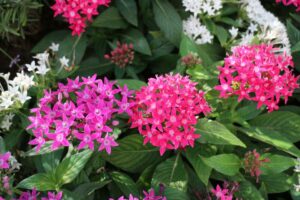Properly Deadhead Pentas

Pentas are beautiful flowering heat-loving plants that are native to central and eastern Africa, Saudi Arabian Peninsula, and Madagascar. Pentas is a flowering plant in the family Rubiaceae and is commonly known as the Egyptian star cluster. These garden beauties produce many flowers that come in an array of colors from purple, white, red, dark pink, etc… what also makes Pentas so unique is the small star-shaped flowers that grow in clusters.
Pentas can be grown as annuals or perennials, hummingbirds and butterflies are attracted to their flowers, Pentas look fabulous when planted in groups or clusters (mass planting). When installing give Pentas a spacing of 1 to 2 ft apart, this shrub can get up to 2-3 ft tall, once establish or mature Pentas are relatively tolerant to periodic drought.
As beautiful as Pentas are their flowers become faded and they must be cleaned (deadheaded) to maintain their beauty and luster. Below we will be discussing how to properly deadhead Pentas.
Affiliate Disclaimer
As an Amazon Associate and the owner of this website, I’ve tracked down special deals for some of the products mentioned here. When you use the links on this page to make a purchase I may get a small commission and you will get a great bargain. It’s a WIN-WIN for both of us.
Deadheading Pentas Procedures
Don’t let the word deadheading give you a scare, it is a simple yet effective way to remove spent or fade flowers from your garden plants. To carry out this procedure simply cut or pinch dead or faded flowers just below the flower stem and just above the first set of healthy leaves that are full.
Repeat this process on all of the faded or dead flowers or depending on the number of flowers that are to be deadhead you might want to consider shearing the plant/plants back entirely. Shear away the top few inches of the plant say about (5 to 10 cm.) so that the spent flowers can be removed. If you discover that new buds are among faded flowers cut the stems just above them.
When is the Best Time to Deadhead
The best time to deadhead is around late spring because few flowering plants including Pentas will have spent flowers, it’s best to work with a schedule. Start early in the morning putting in a few hours in your garden each day that way it will make the task of deadheading easier. If you wait too late in the season (early fall) will make this task of deadheading more difficult.
The Benefits of Deadheading
- Deadheading will increase the aesthetics of flowering plants
- Deadheading will encourage an abundance of flower production
- Deadheading will discourage flowering plants from focusing all of their energy on the seeds instead of the flowers
Bonus Tip with Pentas
Pentas can be used indoors as cut flowers in arrangements, to accomplish this cut back about two-thirds of the flower stalk.
Where to Install Pentas
- Install Pentas in mass planting in a garden bed
- Can be planted in a circular pattern around a tree trunk
- Place them in containers and place the containers on either side of your main door entrance
- Grow Pentas in hanging baskets
- Align them in color masses along a garden walking pathway
- Plant Pentas alongside a fenced area
- Install Pentas alongside a wall
- Place Pentas in containers and place containers on your porch, patio, or deck
Can you think of other places to install Pentas, think outside of the box, and have fun you can do it?
The final words on deading pentas
Deadheading Pentas is that easy, this simple technique is so effective in keeping your Pentas growing healthy as they maintain their beauty. If you are ever wondering how to return your Pentas to their former glory days then deadheading will help with this. This technique has been used on so many flowering plants for the benefits it offers so go for it you will be so happy with the results.
About the author
Norman loves being in the garden, both at home and for his job....
he is 'Natures Little helper' being outdoors, growing his vegetables and flowers from an early age.
Now having spent over 22 years in the profession he want to give some of his knowledge to others...
his vast array of hints and tips you will find scattered over this site will help you no end growing plants in your garden.
